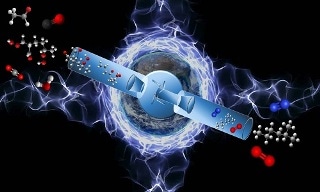Jan 2 2018
There are some prominent similarities between the fuel combustion chemistry inside the engine of a vehicle and chemical reactions generating atmospheric pollutants. In both these reactions, oxygen plays a significant role.
At present, scientists from KAUST have demonstrated that the analysis of the role of oxygen in atmospheric and combustion chemistry can assist researchers not only in reducing air pollution but also in enhancing engines.
 A representative fuel molecule showing oxygen molecules (right, red) and 2-methylheptane (right, grey and white) meet in a jet-stirred reactor. The highly oxygenated molecules that result (left) are detected by advanced mass spectrometry. CREDIT: 2017 Zhandong Wang.
A representative fuel molecule showing oxygen molecules (right, red) and 2-methylheptane (right, grey and white) meet in a jet-stirred reactor. The highly oxygenated molecules that result (left) are detected by advanced mass spectrometry. CREDIT: 2017 Zhandong Wang.
Volatile organic compounds (VOCs) are gaseous molecules released into the atmosphere from the smoke stacks and tail pipes of vehicles, power plants and factories, and also from living plants. Through a series of auto-oxidation reactions, VOCs interact with oxygen from the surrounding air to produce highly oxygenated molecules that cause air pollution and generate aerosols that have an impact on the climate.
Auto-oxidation also takes place upon fuel ignition and combustion. According to Zhandong Wang and Mani Sarathy from the Clean Combustion Research Center, who co-headed the study, unearthing the identity of the molecules from such reactions has been challenging. “The highly oxygenated intermediates produced from auto-oxidation are very reactive and decompose quickly,” stated Wang.
Therefore, Wang, Sarathy and their colleagues created a state-of-the-art experimental setup for sampling the difficult-to-track molecules before being degraded.
We used a sophisticated technique—a jet-stirred reactor coupled with synchrotron radiation photoionization and molecular-beam mass spectrometry—at the Advanced Light Source in Berkeley.
Zhandong Wang, The Clean Combustion Research Center
The researchers also adopted a high-resolution atmospheric-pressure chemical-ionization mass spectrometer at the Analytical Core Laboratory at KAUST to investigate combustion auto-oxidation products.
Prevalent theoretical combustion chemistry models hypothesize that one, or probably two, oxygen molecules have the ability to get coupled to a fuel molecule at the time of auto-oxidation. Wang and Sarathy’s findings indicate that not less than three sequential oxygen-addition reactions, and probably more, can occur.
Our most significant finding is that auto-oxidation processes leading to auto-ignition are much more complex than previously thought. We have shown that many large hydrocarbon and oxygenated fuels exhibit extensive auto-oxidation, and when these pathways are included in models, they significantly alter simulation results.
Zhandong Wang
Upgrading the models will enable the researchers to more precisely reproduce fuel combustion and to prospectively enhance the performance of engines in real time. However, the outcomes of the study are far-reaching. “We are working with the atmospheric scientists from University of Helsinki to further explore analogous auto-oxidation processes in atmosphere and combustion. Our goal is to use our combustion experience to develop models for atmospheric aerosol formation via VOC auto-oxidation. This could significantly improve simulations to predict air pollution and global temperature.”